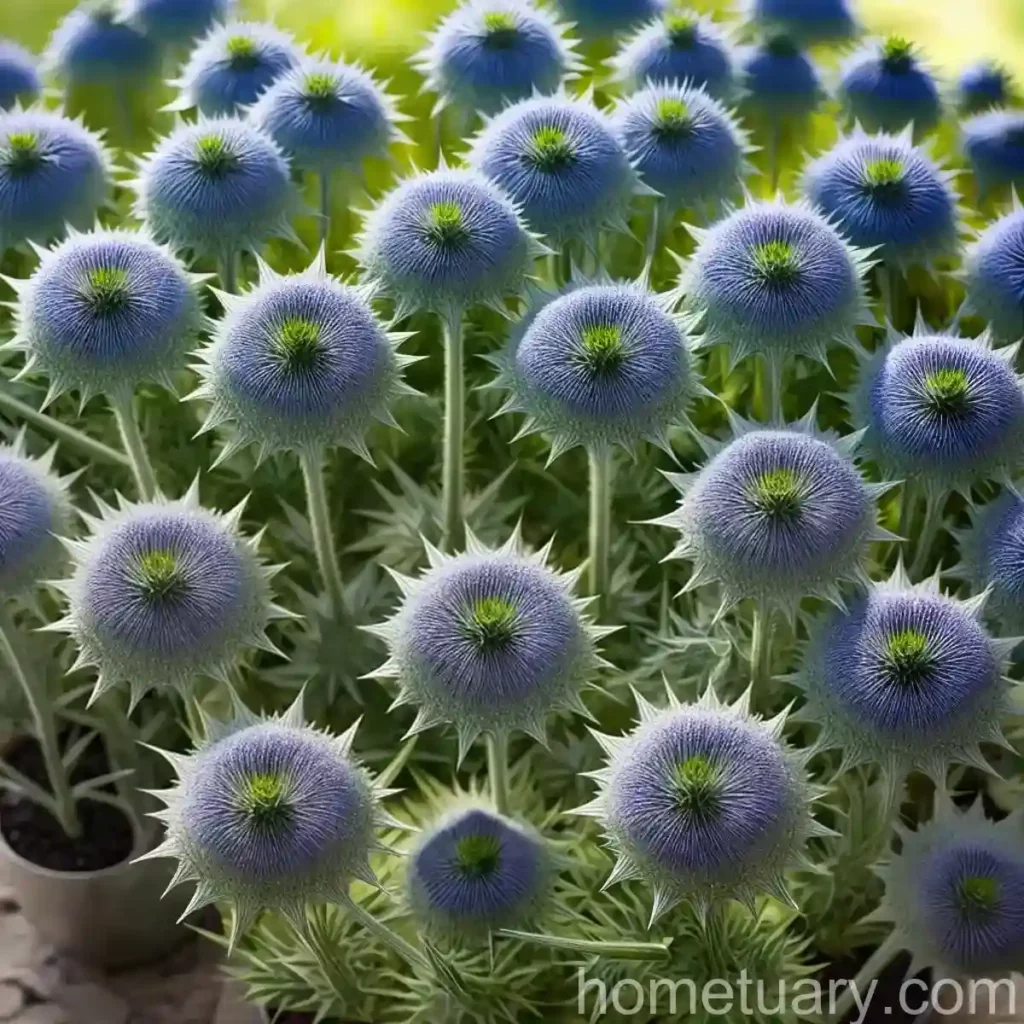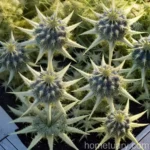Eryngo (Eryngium alpinum): The Alpine Sea Holly
Eryngium alpinum, commonly known as eryngo or Alpine sea holly, is a striking perennial plant that belongs to the family Apiaceae. The plant is native to mountainous regions of Europe and is renowned for its unique and spiky blue flower heads. Eryngium alpinum is prized for its ornamental value, as well as for its potential medicinal and herbal uses. In this comprehensive guide, we will explore the characteristics, cultivation, and uses of eryngo, providing valuable insights for both novice and experienced gardeners.
Key Takeaways – Eryngo (Eryngium alpinum)
- Botanical Name: Eryngium alpinum
- Common Names: Sea holly, alpine sea holly
- Plant Type: Perennial
- Family: Apiaceae
- Height: 18-24 inches
- Flower Color: Blue
- Sunlight: Full sun
- Water: Low to moderate
- Soil: Well-draining, sandy loam
- Hardiness Zones: 3-9
- Uses: Ornamental, medicinal
- Special Features: Drought-tolerant, pollinator-friendly
Now, let’s delve deeper into the various aspects of eryngo, including its cultural requirements, uses, propagation methods, and more.
What is Eryngo (Eryngium alpinum)?
Eryngium alpinum Characteristics
Eryngium alpinum is characterized by its spiky, thistle-like appearance, with deeply lobed, silvery-green leaves that form a basal rosette. The plant typically reaches a height of 18 to 24 inches and produces distinctive cone-shaped flower heads in a striking shade of blue. These flower heads are surrounded by spiky bracts, giving them a captivating and architectural quality. Eryngo blooms in mid to late summer, attracting pollinators such as bees and butterflies to the garden.
Eryngium alpinum Growing Tips
- Planting Time: Spring or fall
- Spacing: 12-18 inches apart
- Growth Rate: Moderate
- Maintenance: Low
Eryngium alpinum Care Guide
Water
Eryngo is a drought-tolerant plant that thrives in well-draining soil and requires minimal watering once established. During the growing season, it’s essential to provide moderate moisture to support healthy growth and flowering. However, it’s crucial to avoid overwatering, as this can lead to root rot and other issues.
Sunlight
Full sun is ideal for eryngo, as it promotes robust growth and abundant flowering. Ensure that the plant receives at least 6-8 hours of sunlight per day. In regions with intense heat, some afternoon shade may be beneficial to prevent stress on the plant.
Fertilizer
Eryngium alpinum is not demanding when it comes to fertilization. A balanced, slow-release fertilizer applied in spring as new growth emerges can support the plant’s nutritional needs throughout the growing season. Avoid excessive fertilization, as this can lead to overly lush foliage at the expense of flower production.
Soil
The ideal soil for eryngo is well-draining and slightly acidic to neutral. A sandy loam soil enriched with organic matter provides an excellent growing medium for this plant. Good drainage is essential to prevent waterlogging, which can be detrimental to the plant’s health.
Eryngium alpinum Varieties
Several cultivars of Eryngium alpinum are available, offering variations in flower color, size, and foliage characteristics. Some popular varieties include ‘Blue Star’ with intensely blue flowers, ‘Silver Ghost’ with silver-tinged foliage, and ‘Glacier Blue’ with large, showy flower heads. These variations allow gardeners to choose the perfect eryngo cultivar to suit their preferences and garden design.
Eryngium alpinum Planting Guide
Hardiness Zones
Eryngium alpinum is well-suited to hardiness zones 3-9, thriving in cooler climates with well-defined seasons. The plant’s adaptability to a wide range of climates makes it a versatile choice for gardeners across various regions.
Pollinator Plant
As a nectar-rich plant with striking flowers, eryngo acts as a valuable source of food for pollinators such as bees and butterflies. By incorporating this plant into the garden, gardeners can support and promote local pollinator populations, contributing to the overall health of the ecosystem.
Eryngium alpinum Medicinal Uses
Eryngium alpinum has a history of traditional medicinal uses, with various parts of the plant being employed for their therapeutic properties. The roots of some Eryngium species are utilized in herbal medicine to treat conditions such as urinary tract infections, kidney stones, and digestive issues. However, it’s important to note that extensive research and clinical trials are necessary to validate the plant’s medicinal efficacy and safety.
Eryngium alpinum Herbal Properties
In addition to its potential medicinal uses, eryngo is valued for its herbal properties. The plant has been historically employed in folk medicine for its diuretic and anti-inflammatory properties. Herbal preparations using eryngo may be used to support urinary system health and address certain inflammatory conditions. As with any herbal remedy, it’s crucial to consult a healthcare professional before using Eryngium alpinum for medicinal purposes.
Eryngium alpinum Perennial Plant
Eryngo is a perennial plant, meaning that it undergoes repeated growth and flowering cycles over multiple years. Its longevity and enduring nature make it a valuable addition to perennial borders, rock gardens, and naturalistic landscapes. By establishing a perennial presence in the garden, Eryngium alpinum contributes to the overall structure and beauty of the outdoor space.
Eryngium alpinum Garden Design
Landscape Ideas
Eryngo can be integrated into various garden designs to add texture, color, and visual interest. Its spiky form and unique flower heads make it an excellent choice for contemporary and naturalistic landscapes. It pairs well with grasses, coneflowers, and other prairie-style plants, creating a captivating and dynamic composition.
Companion Plants
When selecting companion plants for eryngo, consider species that thrive in similar growing conditions, particularly in terms of sunlight and soil moisture. Lavender, veronica, sedum, and ornamental grasses complement eryngo’s visual appeal while sharing its cultural preferences. Creating harmonious plant combinations enhances the overall aesthetic and ecological value of the garden.
Eryngium alpinum Propagation Methods
Seed Starting
Eryngium alpinum can be propagated from seeds sown directly into the garden soil or started indoors for early establishment. Sow the seeds in well-draining soil in late winter, providing bottom heat and consistent moisture to facilitate germination. Once the seedlings have developed several true leaves, they can be transplanted into their permanent positions in the garden.
Division
Dividing mature clumps of eryngo is a reliable method of propagation that rejuvenates the plant and produces new individuals. Divide the plant in early spring before new growth emerges or in early fall after flowering. Ensure that each division has a good root system and several healthy shoots to ensure successful establishment.
Eryngium alpinum Zone Requirements
Eryngium alpinum is well-suited to a wide range of hardiness zones, from 3 to 9, making it adaptable to diverse climatic conditions. The plant’s resilience in varying environments enhances its appeal to gardeners seeking a versatile and reliable ornamental addition to their landscapes.
Eryngium alpinum Container Popularity
Eryngo’s compact habit and striking appearance make it well-suited for container cultivation. When grown in containers, it can be showcased on patios, balconies, or other outdoor spaces, adding a touch of elegance and visual intrigue. Select a spacious container with adequate drainage, and use a well-draining potting mix suitable for perennial plants.
Container Common Diseases
When grown in containers, eryngo may be susceptible to certain diseases that can affect its overall health and vigor. Proper container management and vigilant monitoring can help prevent common diseases such as root rot, powdery mildew, and botrytis blight. Implementing appropriate cultural practices and ensuring optimal growing conditions can mitigate the risk of disease development.
Disease Diagnosis
It’s essential to be vigilant for any signs or symptoms of disease in container-grown eryngo. Early diagnosis of diseases allows for prompt intervention and treatment, thereby minimizing the impact on the plant’s well-being. Consulting with a plant health specialist or extension service can help accurately diagnose and address potential disease issues.
Common Pests
Like many ornamental plants, eryngo may attract pests such as aphids, spider mites, and caterpillars. Regular inspection of the plant, coupled with proactive pest management strategies, can help keep pest populations in check. Natural predators, cultural practices, and targeted treatments can be employed to maintain a healthy growing environment for containerized eryngo.
Botanist’s Tips
Pruning Techniques
Eryngium alpinum benefits from regular deadheading to promote continuous flowering and prevent self-seeding. As the flower heads fade, remove them to encourage the emergence of new blooms and maintain the plant’s tidy appearance. Additionally, pruning back the foliage in late fall or early spring helps rejuvenate the plant and promotes vigorous growth in the subsequent season.
Soil Requirements
The soil requirements for eryngo center around good drainage and aeration. Amending the soil with organic matter such as compost or well-rotted manure can enhance its structure and nutrient content. Avoid compacted or waterlogged soil, as this can compromise the plant’s root health and overall vitality.
Growing Season
Eryngium alpinum’s growing season extends from spring to late summer, coinciding with its active vegetative growth and flowering period. Providing adequate sunlight, moisture, and nutrition during this period facilitates the plant’s development and ensures the production of vibrant flowers.
Fun Facts
- The genus name Eryngium is derived from the Greek word “eryngion,” which refers to a type of thistle.
- Eryngo has been historically associated with protection and warding off evil spirits, leading to its use in traditional cultural practices.
- The spiky bracts surrounding eryngo’s flower heads serve as both a visual attraction and a protective feature, deterring herbivores and adding to the plant’s distinct appearance.
Links to External Resources
For further information on Eryngium alpinum, varieties, and cultivation, refer to the following resources:
- Royal Horticultural Society – Eryngium alpinum
- Missouri Botanical Garden – Alpine Sea Holly
- Fine Gardening – Eryngium alpinum
In conclusion, Eryngium alpinum, or eryngo, stands out as an exceptional perennial plant with ornamental, ecological, and potentially medicinal significance. Its striking appearance, adaptability, and low-maintenance nature make it a valuable addition to diverse garden settings. By incorporating this captivating plant into garden designs and landscapes, individuals can appreciate its unique beauty and contribute to the well-being of local pollinators. Whether grown in the garden bed or a container, eryngo’s enduring charm and allure make it a standout choice for ornamental gardening enthusiasts.
Would you like to ask anything else about Eryngo (Eryngium alpinum)?















